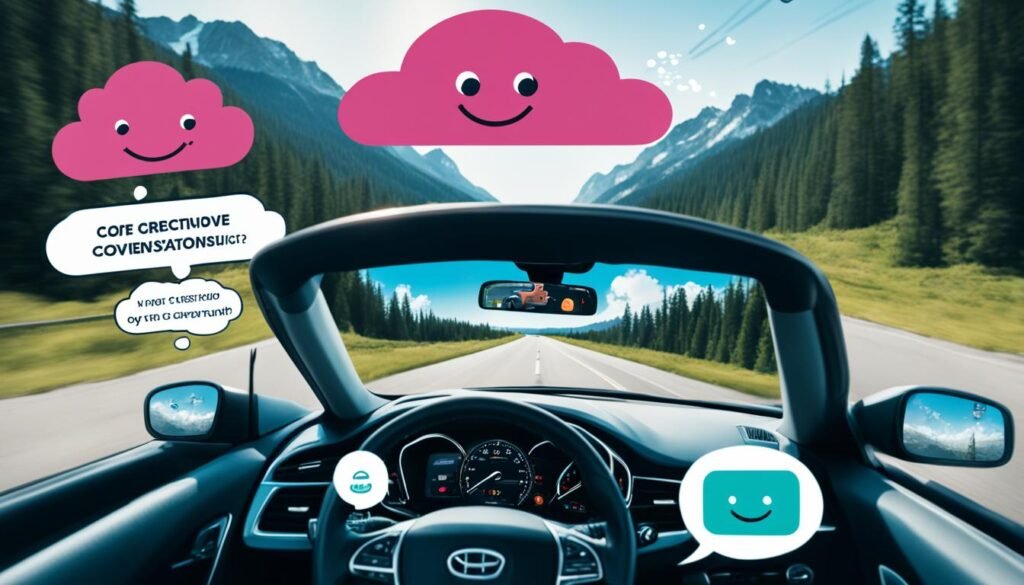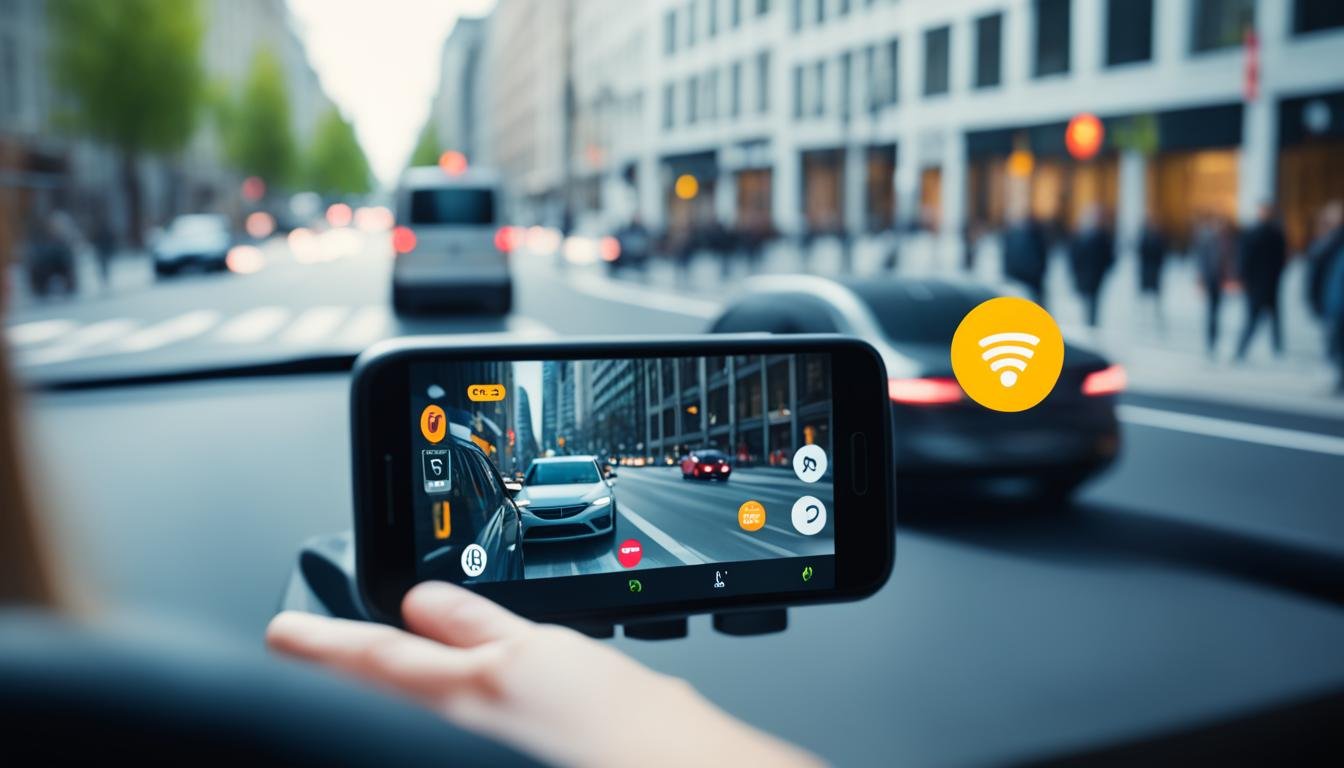Did you know about 25% of all car crash deaths in the U.S. are due to distracted driving? This shocking fact shows how serious the problem is. It tells us we must act now to make our roads safer.
Today, our world is full of technology, connecting us in many ways. But this has also brought a big problem: distracted driving. It’s not just texting or calling while driving. Other risks are out there, threatening everyone on the road.
In this article, we’ll look into what makes distracted driving so dangerous. We’ll talk about the different ways it can happen and the impact it has. We’ll also explore ways to fight this issue, aiming for safer roads for all.
Key Takeaways:
- Approximately 25% of all motor vehicle crash fatalities in the United States are caused by distracted driving.
- Distracted driving includes more than texting. It covers actions like eating, grooming, daydreaming, using car tech, and feeling tired.
- Cognitive distractions, such as daydreaming and trying to do several things while driving, can make driving worse.
- Besides causing deaths and injuries, distracted driving can also deeply affect survivors. It has big impacts on society and the economy too.
- Fighting distracted driving needs stronger laws, technology, and campaigns to educate and raise awareness.
The Hidden Dangers of Distracted Driving
Many think distracted driving is just texting or talking on the phone. Yet, other hidden dangers on the roads pose risks. Being aware and minimizing these dangers is key for safety.
Eating and driving is a common yet risky practice. It seems convenient but distracts you from the road. Grooming, like fixing hair or applying makeup, also diverts focus. These activities can lead to devastating consequences.
“Eating and grooming while driving might seem like harmless multitasking, but they are distractions that can lead to accidents,” warns Dr. Sarah Johnson, a renowned road safety expert.
Passenger distractions are significant risks too. Conversations or turning to someone in the back can divert attention. Even playful kids can cause distractions. A moment’s distraction can lead to accidents.
Daydreaming is another hidden danger. Letting your mind wander affects your reaction time and decisions. Staying focused and present is vital.
New car technologies also distract drivers. Touch screens, GPS, and infotainment systems can pull your attention away. Looking away for even a second is dangerous.
Fatigue is a dangerous form of distraction as well. Long drives, especially at night, can make you drowsy. This affects your focus and reaction speed. Like other distractions, fatigue is dangerous.
To tackle distracted driving’s hidden dangers, recognizing them is the first step. By avoiding distractions and focusing on safety, we can make roads safer. Always prioritize driving over other activities.
The Hidden Dangers of Distracted Driving
| Hidden Dangers | Description |
|---|---|
| Eating and driving | Diverts attention from the road |
| Grooming while driving | Takes focus away from the task at hand |
| Distractions from passengers | Conversations and interactions that divert attention |
| Daydreaming | Wandering thoughts impairing reaction times and decision-making |
| In-car technology | Features that distract from the primary task of driving |
| Fatigue as a distraction | Drowsiness impairs concentration and reaction times |
Understanding the True Definition of Distracted Driving
Distracted driving is often thought to mean only texting or talking on the phone when driving. But it’s much more than that. It includes all activities that take a driver’s attention away from the road. This can risk everyone’s safety. Understanding all aspects of distracted driving helps in dealing with these dangers.
Many don’t realize that eating while driving is a distraction. Some think eating on the go saves time. Yet, dealing with food can take your focus off driving. This can lead to risky situations on the road.
Grooming while driving is also distracting. Doing things like applying makeup or fixing hair takes attention away from driving. A few seconds with your eyes off the road can be very dangerous.
Talking with passengers might seem safe, but it can distract a driver. Conversations can make you lose focus on driving. It’s vital to stay alert while talking and keep an eye on the road.
Daydreaming is another big distraction. It can make a driver less aware of what’s happening around them. Staying focused on driving is very important to avoid accidents.
Today, in-car technology is a common source of distraction. Using gadgets for music or GPS can divert attention. Drivers should learn these features before hitting the road. Voice commands or hands-free options can help reduce distractions.
Fatigue greatly affects driving. It makes it hard to react quickly and increases the chance of falling asleep. Getting enough rest before driving is crucial.
“Distracted driving isn’t just about texting and talking on the phone; it includes a wide range of activities that divert a driver’s attention from the road.” – AAA Foundation for Traffic Safety
Understanding the true meaning of distracted driving lets us clear up common misunderstandings. By addressing issues like eating, grooming, chatting, daydreaming, using in-car tech, and dealing with fatigue, we can come up with ways to stop them. This is key to preventing distractions on the road.
Types of Distracted Driving
| Type | Description |
|---|---|
| Eating while driving | Consuming food or drink while operating a vehicle |
| Grooming while driving | Performing personal grooming tasks such as applying makeup or shaving |
| Conversations with passengers | Engaging in discussions or interactions with fellow passengers |
| Daydreaming | Being mentally absent or lost in thought while driving |
| In-car technology usage | Interacting with navigation systems, touchscreens, or other technological features inside the vehicle |
| Fatigue | Drowsiness or exhaustion while operating a vehicle |
It’s key to know the full range of distracted driving to make our roads safer. By understanding these distractions and their impacts, we can avoid them. Let’s all aim for safe and focused driving. This is vital for our safety and for others on the road too.

The Mind Games that Impair Driving Abilities
In addition to visual and manual distractions, cognitive distractions can impair driving abilities. Daydreaming and trying to do two things at once while driving can take your attention off the road. This increases the chance of crashes. It’s important to know about these mental traps and find ways to avoid them for safer driving.
Daydreaming, a common distraction, happens when thoughts drift away from driving. This leads to less awareness of what’s around and slower reactions. To stop daydreaming, keep your mind and eyes on driving.
Another distraction is doing multiple tasks at once, like talking on the phone or using tech in the car. Research has shown that this lowers our ability to think clearly and makes accidents more likely. We should focus on driving and avoid splitting our attention.
“The challenge of multitasking is often underestimated. Dividing attention between multiple tasks can significantly impair our ability to react to changing road conditions and unexpected events.”
To deal with cognitive distractions, we must recognize them first. Here are ways to fight these mental distractions:
- Stop daydreaming by keeping focused on the road and what’s around. Repeat to yourself, “Eyes on the road, mind on the task.”
- Avoid doing many things by turning off phone notifications and using less tech in the car while driving. If needed, stop at a safe place to handle distractions.
- Use mindfulness to help focus better and reduce wandering thoughts. Techniques like deep breathing and picturing things can keep you concentrated on driving.
Following these tips can make us better drivers and lower the dangers from mental distractions. Stay alert, keep focused, and always put safety first on the road.

| Visual Distractions | Manual Distractions | Cognitive Distractions | |
|---|---|---|---|
| Definition | Distractions that take your eyes off the road | Distractions that take your hands off the wheel | Distractions that divert your attention from driving |
| Examples | Texting, reading, looking at scenery | Typing, eating, grooming | Daydreaming, multitasking, using in-car technology |
| Risk Level | High | High | High |
The Alarming Reality of Distracted Driving
Distracted driving is a huge problem that causes lots of harm. It leads to many deaths and injuries every year. The numbers are shocking.
In 2019 alone, *3,142* deaths were linked to not paying attention while driving. This was about *8.7%* of all car crash deaths in the U.S.[i]. These are not just numbers. They represent real people and the sorrow of many families. Distracted driving also injures around *400,000* people each year[ii].
But there’s more than just physical injury. The mental effects are huge too. Crashes can cause trauma, anxiety, and PTSD. These issues can change someone’s life forever, impacting their happiness and mental health[iii].
Distracted driving also hurts our society and economy. It’s very expensive, due to healthcare costs and lost work. Every year, it’s estimated to cost the U.S. about $129 billion[iv].
We need to take this seriously and work on solutions. By raising awareness and enforcing laws, we can reduce these sad incidents. Let’s make our roads safer for everyone.
| Year | Number of Fatalities |
|---|---|
| 2016 | 3,450 |
| 2017 | 3,166 |
| 2018 | 2,841 |
| 2019 | 3,142 |
| 2020 | Data for 2020 is not yet available |
Table: Number of Fatalities Caused by Distracted Driving in the United States[v].
[i] National Highway Traffic Safety Administration (NHTSA). Distracted Driving: 2019 Data.
https://www.nhtsa.gov/risky-driving/distracted-driving
[ii] National Highway Traffic Safety Administration (NHTSA). 2018 Traffic Safety Facts Research Note: Distracted Driving.
https://crashstats.nhtsa.dot.gov/Api/Public/ViewPublication/812926
[iii] Centers for Disease Control and Prevention (CDC). Mental Health Conditions: Post-Traumatic Stress Disorder (PTSD).
https://www.cdc.gov/traumaticbraininjury/mental-health-conditions.html
[iv] National Safety Council. The Real Cost of Distracted Driving.
https://www.nsc.org/road-safety/distracted-driving/cost-of-distracted-driving
[v] National Highway Traffic Safety Administration (NHTSA). Distracted Driving: 2016-2019 Data.
https://www.nhtsa.gov/risky-driving/distracted-driving
Combating Distracted Driving: Initiatives and Solutions
Distracted driving poses a significant threat to road safety. There are various initiatives and solutions to effectively combat this issue. By focusing on legislation, technological solutions, and education, we can prevent distracted driving accidents.
Legislation and Enforcement
Legislation and enforcement are key to addressing distracted driving. Stricter laws and regulations discourage drivers from engaging in dangerous behaviors. With penalties, like fines or license suspensions, we encourage safer driving habits.
Technological Solutions
Technology offers innovative solutions to combat distracted driving. Hands-free devices and voice-activated controls help drivers stay connected safely. These solutions reduce manual distractions and promote safer driving practices.
Education and Awareness
Education and awareness campaigns are crucial in preventing distracted driving. They raise awareness about the risks and consequences. Educational programs offer tips for avoiding distractions, empowering drivers to make safe choices.
“Education and awareness are key in reducing distracted driving incidents. By educating people about the dangers, we foster responsible driving and safer roads.”
To fight distracted driving, we combine legislation, technology, and education. It’s vital for everyone to work together for road safety. By doing so, we can reduce distractions and save lives.
| Initiatives and Solutions | Description |
|---|---|
| Legislation and Enforcement | Implementing stricter laws and enforcing penalties to discourage distracted driving. |
| Technological Solutions | Introducing hands-free devices and voice-activated controls to minimize manual distractions. |
| Education and Awareness | Raising awareness about the dangers of distracted driving and providing education on safe driving practices. |
Conclusion
Distracted driving poses a big risk on the road. It’s crucial to understand the hidden dangers, like eating, daydreaming, and tech use while driving. By being aware, we can stop accidents and keep everyone safe.
We’ve looked at what distracted driving really means. We’ve seen how it affects our ability to drive safely. We’ve also looked at the scary statistics of accidents caused by distractions.
To fight this problem, we’re seeing new solutions. Stricter laws, new technology, and campaigns to educate drivers are making a difference. These efforts help prevent distracted driving.
If distracted driving has affected you or someone you know, help is available. Call Super Attorneys Of Irvine at 949-996-9546 or visit businesslawyersirvine.com. They have experts ready to help with legal advice.
Staying informed and focused on the road is key. By working together, we can prevent distracted driving. This will make our communities safer for everyone.

